This is the best Peach Ice Cream recipe, made using simple ingredients like eggs, cream, milk, and fresh peaches for an ultra-creamy and fruit-forward taste and consistency. This is a classic peach ice cream recipe made with a custard base that requires an ice cream churner.
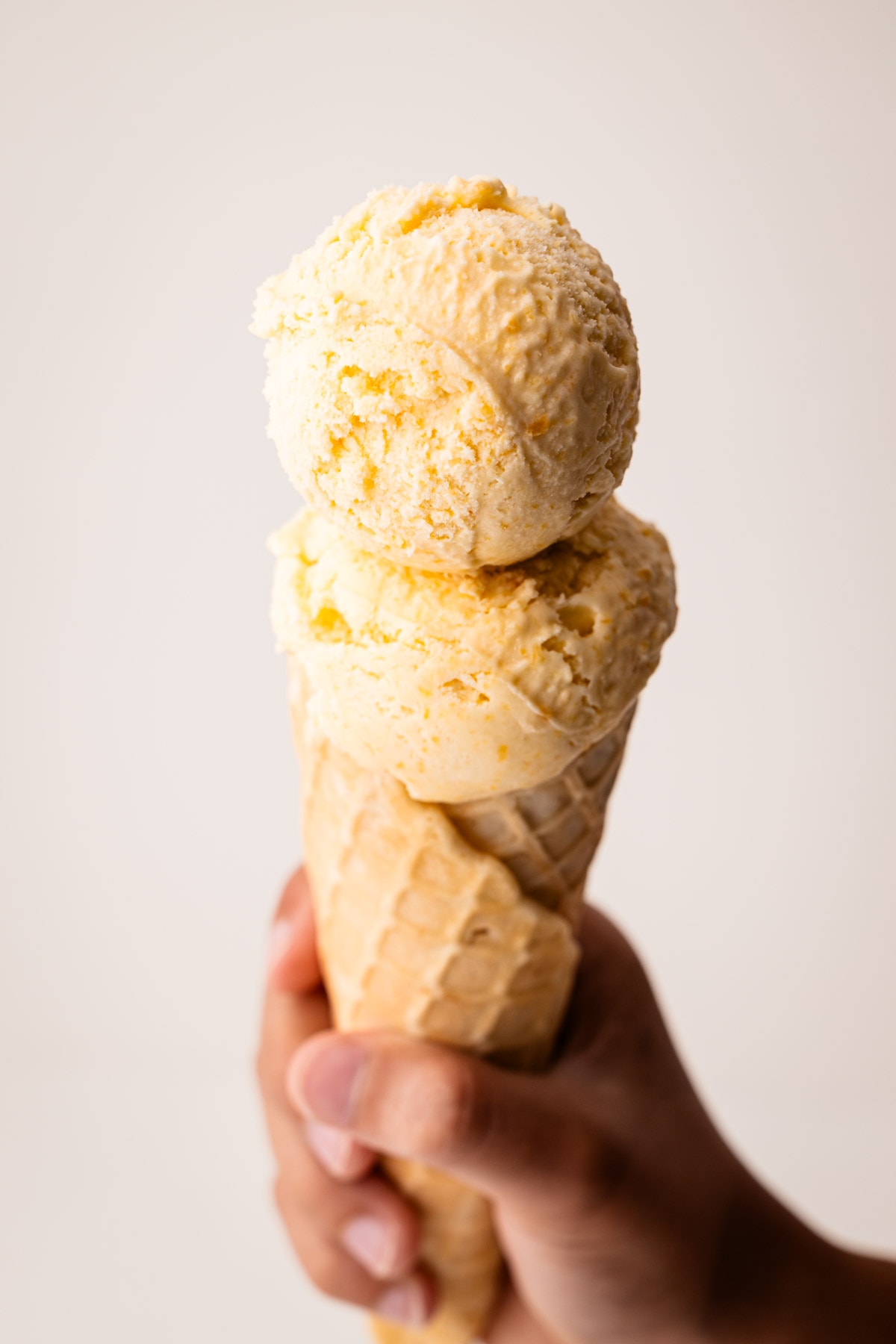
Want to save this recipe?
Enter your email & I'll send it to your inbox. Plus, get weekly updates from me!
If there is any ice cream to make at home, it's Peach Ice Cream. And this recipe was by far the most asked for when I put out a call on Instagram a few months ago for ice cream recipe requests. Homemade Peach Ice Cream is incredibly fresh, and when made correctly, it strikes the ideal balance between real fruit and cream.
Finding that perfect balance can be tricky, but I think I nailed it with this recipe! It packs in as much peach flavor as possible, and uses a secret (all-natural) ingredient to help keep it creamy and scoopable, even straight from the freezer.

Behind the Scenes of the Development Process
Developing this Peach Ice Cream recipe was as challenging as I expected, due to two main problems:
The first hurdle involved incorporating fresh fruit into the ice cream. Fruit has a high water content, and that can contribute to excess ice crystallization, compromising the creamy texture that we all expect of ice cream.
Fortunately, I had already discovered a solution for this problem while perfecting my Strawberry Ice Cream recipe: adding milk powder. Milk powder works its magic to keep the mixture creamy. I'll dive deeper into why milk powder works below.
The second issue I ran into while developing this recipe was amplifying the peach flavor. Peach is a delicate flavor that can easily be overshadowed by other ingredients. Each time I tested the recipe I continued to add more and more fruit to the base, trying to really highlight the subtle peach flavor. Of course, I had to be careful not to add too much, as it would introduce excess water, and thus mess up the texture.
Ultimately, the final ingredient I turned to to make this peach recipe outstanding was almond extract. Despite how different almonds and peaches might seem at the outset, they're actually closely related genetically (along with cherries and other stone fruit) and have similar and complementary flavor profile.
Using just a touch of almond extract helps amplify the peach flavor and gives it more depth. That little bit of almond extract makes the peaches taste buttery and intense in all the best ways.
So, let's get to making it, shall we? The text below offers tons of tips and helpful notes, or you can scroll to the bottom to grab the recipe and get started!

Ingredients Needed
Here is an overview of the ingredients needed for this recipe. The full recipe is listed below in greater detail.
- fresh, ripe peaches
- lemon juice
- granulated sugar
- dry milk powder (see below for more)
- eggs
- coarse kosher salt
- heavy cream
- whole milk
- cinnamon (just a small pinch, to help round out the flavor)
- almond extract (this is again helping to round out the peach flavor and can be skipped if there is a nut allergy)
What is Milk Powder?
Milk powder, also known as powdered or dry milk, is just milk that has been evaporated to remove its water content, leaving behind a dry powder. It can be found as both nonfat and whole milk, and either will work for this recipe.
When it comes to adding milk powder to ice cream, it has two major benefits: it improves the texture and it improves the flavor.
Milk powder is hygroscopic, which means it has the ability to absorb moisture and bind water. Using it allows you to incorporate a large amount of peaches (which contain a lot of water) to the ice cream base without it getting icy.
The concentrated milk powder also imparts a creamy, rich taste to the ice cream without having to add excess amounts of heavy cream, so it keeps the ice cream lighter.
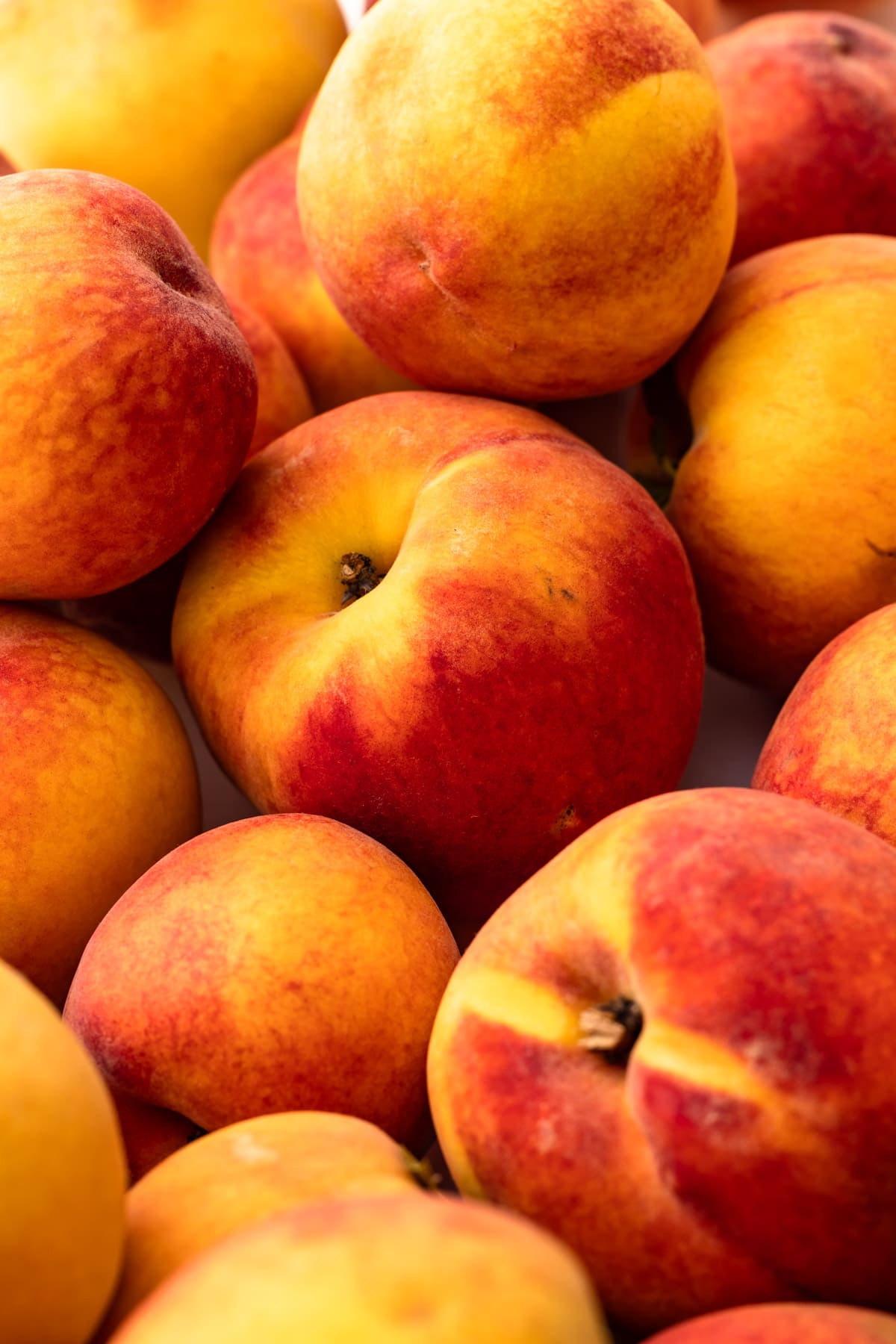
Let's Talk Peaches
It's important that your peaches are ripe. If you use an unripe, flavorless peach in this ice cream, those factors won't magically change when cream and sugar are added to it, despite the fact that the peaches are cooked down a little bit.
A good way to ensure you have a quality peach, aside from buying it in-season and from a reputable source, is to smell it and feel it. The peach should smell peachy! And it should give in easily with a little gentle squeeze.
How to Ripen Peaches
If you have local peaches that are in season, but they aren't quite ripe, that's ok! You can "condition" (AKA ripen) the peaches by leaving them at room temperature, stem side down.
I usually leave them on a kitchen towel-lined sheet tray. Depending on the peach, it can take 1-3 days to reach peak ripeness. Check them every day.
Once they are fragrant and just soft, they are ready to use.
Want to use frozen peaches? That's absolutely fine, so long as they're high-quality and will contribute good peach flavor. Let them defrost in the sugar and lemon juice in the pot in step 1 of the recipe.

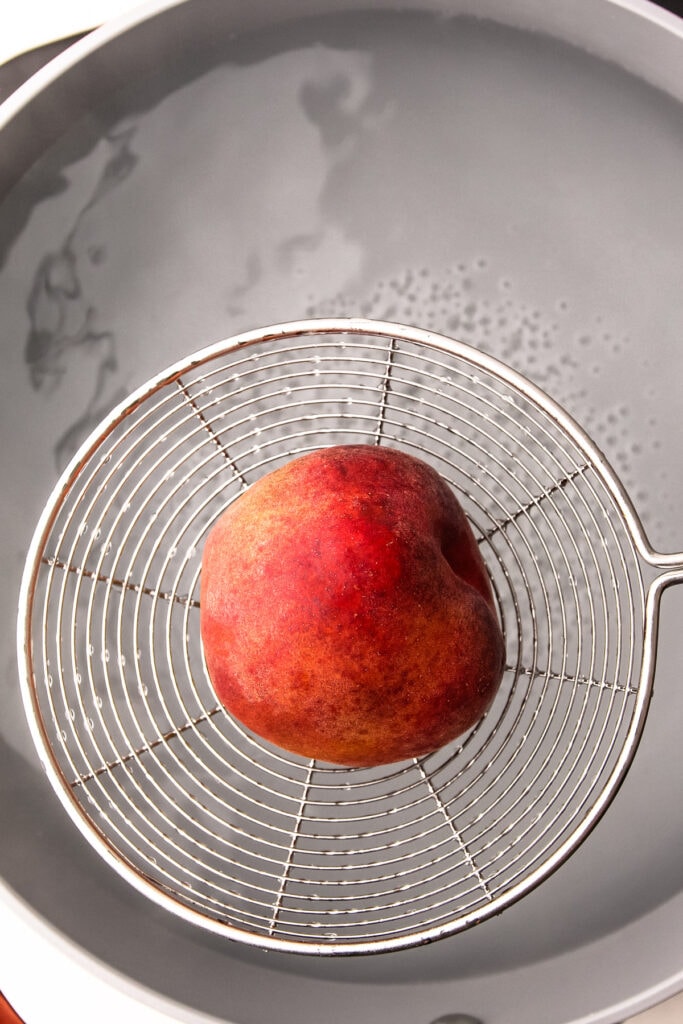
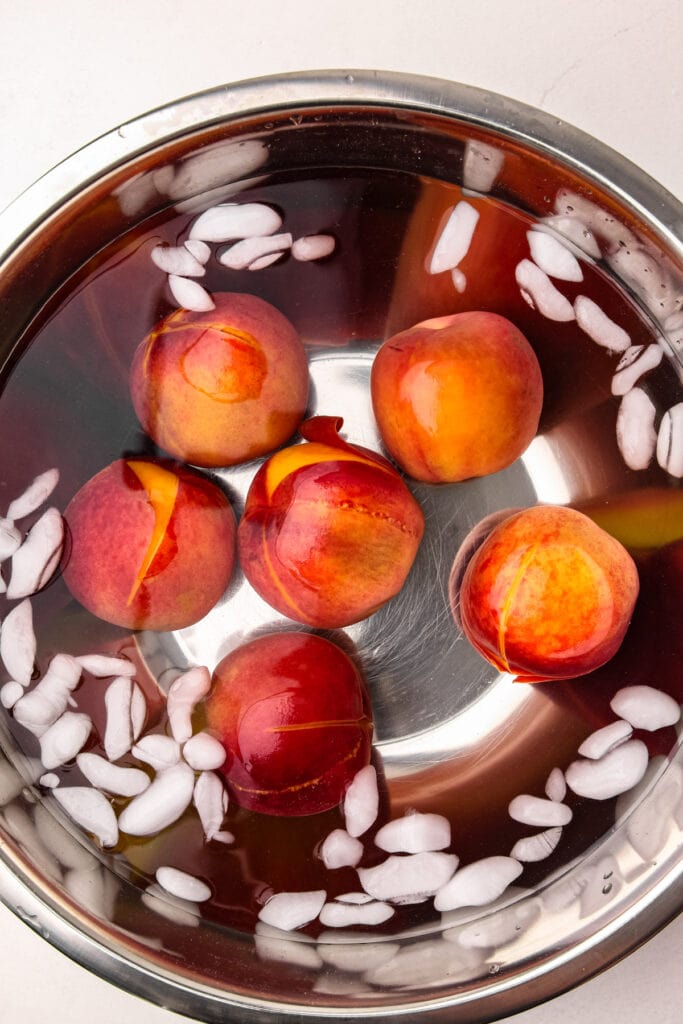

How to Peel Peaches
The peaches should be peeled for this recipe.
I wrote an entire Guide to Peeling Peaches if this is new to you. You can check that out. Or, a tl:dr section from it:
The easiest way to peel a peach is through the blanching method. Blanching is a cooking technique that involves briefly submerging a food item in boiling water and then immersing it in ice water to halt the cooking process rapidly.
Blanching the peach helps loosen the skin so it easily slips off, and in my opinion, is the best way to peel a peach.
Here are the brief instructions:
- Boil a large pot of water
- Clean and dry the peaches
- Slice a very thin "x" on the bottom of the peach
- Place the peaches in the boiling water for about 30-60 seconds
- Immediately transfer the peaches to an ice bath
- Once cooled, transfer them to a towel to dry
- Carefully peel off the skin in four sections.

Useful Tools to Make This Recipe
Here is a list of some of the primary tools I use in this recipe. You won't necessarily choose to use them all, but they are exactly what I used. Any links may contain affiliate links.
- 1-2 medium heavy-bottomed saucepans
- one large metal bowl, one medium metal bowl
- immersion blender or other small capacity blender (to blend up the peaches)
- fine-mesh strainer
- whisk and spatula
- ice cream maker
- containers to store the ice cream
- kitchen essentials: measuring utensils
Custard Vs. Philadelphia Style Ice Cream
There are two distinct styles of ice cream: custard (or French-style) and no-heat (or Philadelphia-style).
Generally speaking, custard-style ice cream is cooked on the stovetop with eggs, and Philadelphia-style ice cream is prepared by simply mixing the ingredients (without eggs) and chilling them.
I almost always prefer custard-style (almost! but with some exceptions).
This peach ice cream recipe uses a custard base.
While many custard recipes use egg yolks for their lecithin content, which stabilizes the emulsion and prevents large ice crystal formation, in my recipes, depending on the flavor, I use a mix of whole eggs and yolks for different flavors. The proteins in egg whites still contribute some stabilization even without lecithin.
This peach ice cream recipe uses just two whole eggs instead of a large quantity of yolks only (many recipes call for 6). Using a higher quantity of egg yolks does aid in the texture of the ice cream, but I feel like it also masks the peach flavor.
There are also a ton of no-churn style ice creams out there. I've tried a few and I did not like them. Unfortunately, I can't offer suggestions on how to make this recipe without an ice cream churner.

Overview of Steps
Here is a simple overview of the recipe. For the full recipe, scroll down to the end of this article.
- Freeze the ice cream machine canister if necessary
- Cook the peaches, and blend them until they're semi-smooth (with some small pieces of peach ok)
- Whisk together all of the ice cream base ingredients
- Heat on the stove top
- Strain and immediately chill
- Add the peach puree to the base
- Chill the ice cream base overnight
- Spin / churn the ice cream base to a soft serve consistency
- Harden the ice cream to desired consistency in the freezer
- Scoop and enjoy!
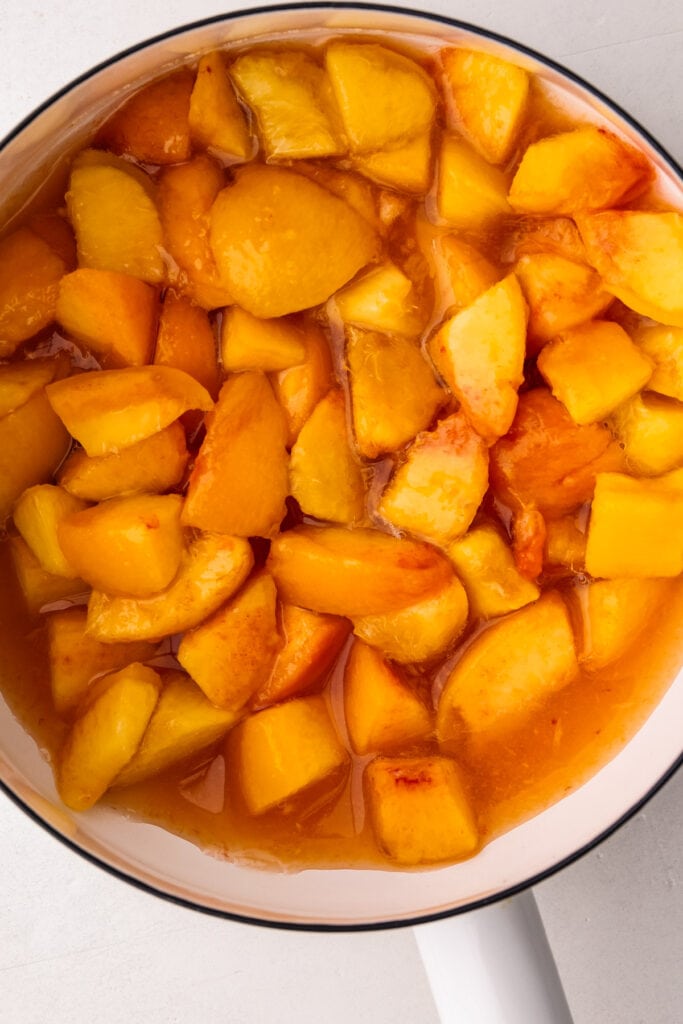

Cooking the Peaches
This recipe requires the peaches to be cooked separately first. This step slightly reduces the moisture content of the fruit, which helps in the texture and flavor of the finished ice cream.
The peaches are cooked with sugar and lemon juice, simmering gently for 5 minutes. Following that, the peaches are blended (I recommend using an immersion blender due to the small quantity of fruit) until they reach a nearly smooth consistency, with some small bits of peach still intact.
This peach puree will not be cooked with the ice cream custard. It will be added to the ice cream custard after it is cooked.
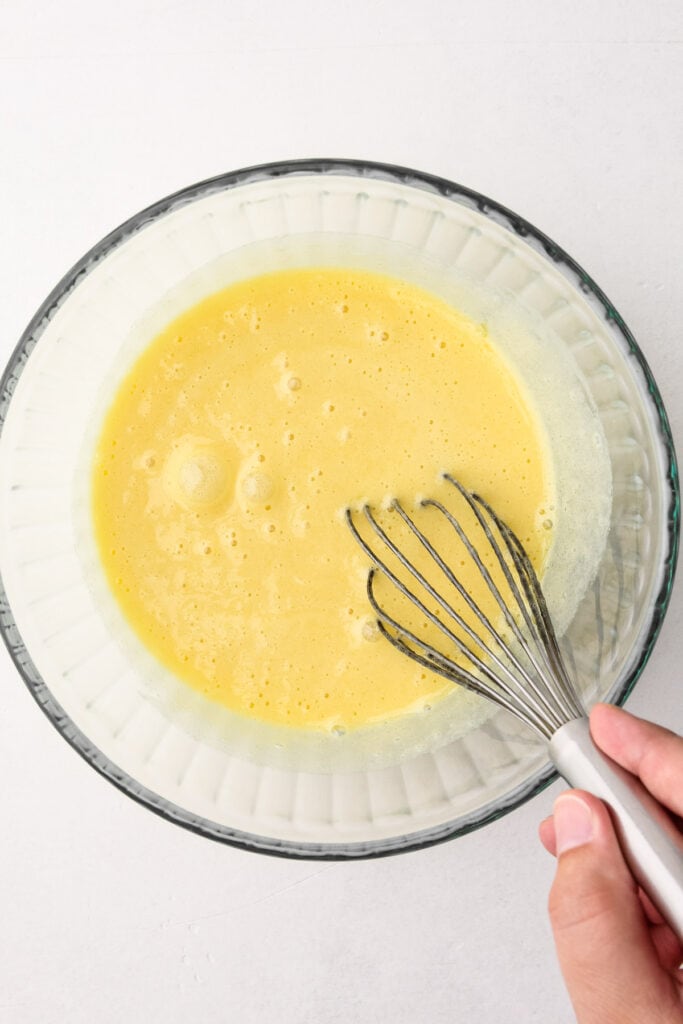
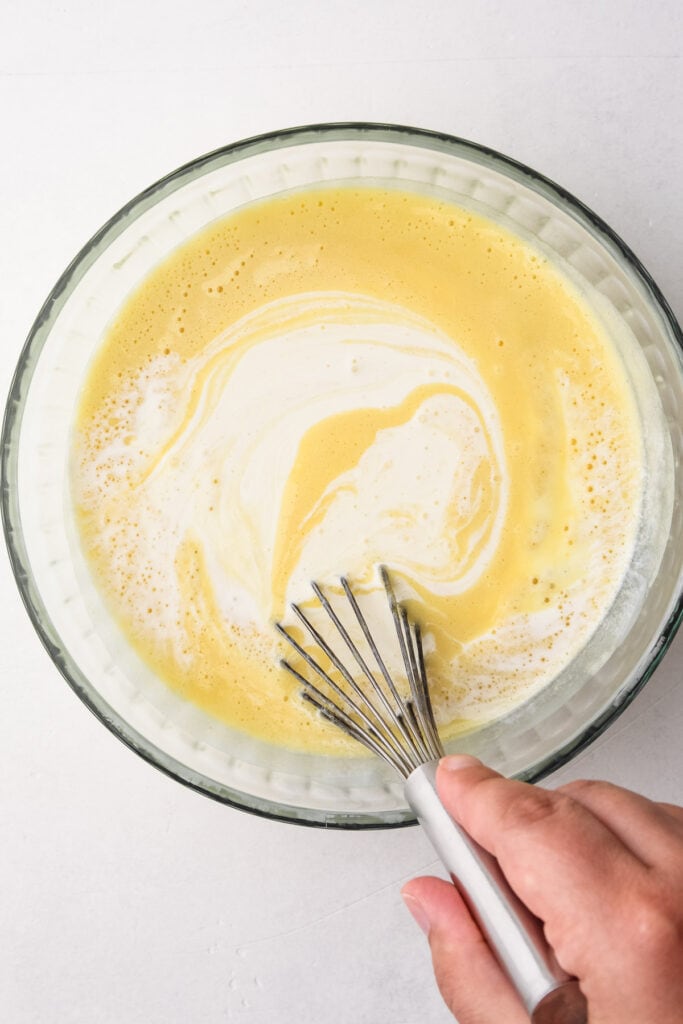
Why No Tempering is Needed
I'm all for streamlining processes, and I'm happy to share that tempering eggs is entirely unnecessary when making an ice cream base.
You might be wondering why I'm saying tempering isn't necessary when almost all custard ice cream recipes call for it, right? And I think the honest answer is: because it's how things have always been done, and often times once we learn something in the kitchen, we don't question it and we just do it.
However, I'm always questioning why we do things the way we do in the kitchen, and this is especially true the longer I've been doing this job.
I find it unnecessary to temper the eggs since they will be gradually heated from the get-go. In addition, the added sugar and even distribution beforehand (aka whisking really well) helps protects the eggs from scrambling before the custard has set.
Tips for Successful Making Ice Cream Custard
The key components in custard are the eggs, which provide structure, richness, and stability, as well as the fat molecules that create a rich mouthfeel when they are suspended in the liquid. Slowly heating the custard to 175º causes the protein in the eggs to denature, meaning the egg proteins unravel and then eventually bond back together, resulting in a thickened texture.
As mentioned above, this recipe forgoes the typical process of tempering, because it’s truly unnecessary, however, follow these tips to ensure success with your custard:
- Whisk the sugar and milk powder together first to evenly disperse the powder, and then add the eggs and whisk vigorously before cooking. The even distribution of these ingredients helps keep the mixture homogenized during cooking.
- Use a medium heavy-bottomed saucepan, which helps distribute heat evenly and reduces the risk of scorching or burning the custard. Using too large of a pot can increase the speed at which the eggs cook due to the increased surface area, making it easier to overcook them.
- Use medium to medium-low heat. Controlling the temperature is important to avoid curdling or cooking the eggs too quickly (as mentioned above).
- Stir constantly, taking care to get into the edges of the pan. A rubber spatula is best for this task.
- Don’t walk away. At most, this process takes about 10 minutes. But the custard can go from perfectly done to overcooked (AKA curdled) in a few seconds.
- Use a thermometer, if possible. The recipe calls for cooking the custard to 175Fº initially. Make sure to take the temperature from the middle of the liquid to ensure accuracy. Once it reaches 175Fº, pull it off the heat and stir for about a minute to let the custard slowly come up to 180Fº before straining into an ice bath. 180Fº is the ideal temperature of the custard, but going over that mark is getting dangerously close to boiling it.
- Speaking of straining, do strain the custard. Often the chalazae from the egg white tends to get cooked, and it’s best to strain that out.
- Use an ice bath. An ice bath will quickly bring the custard down to temperature, which is always a good idea. See below for more on this!
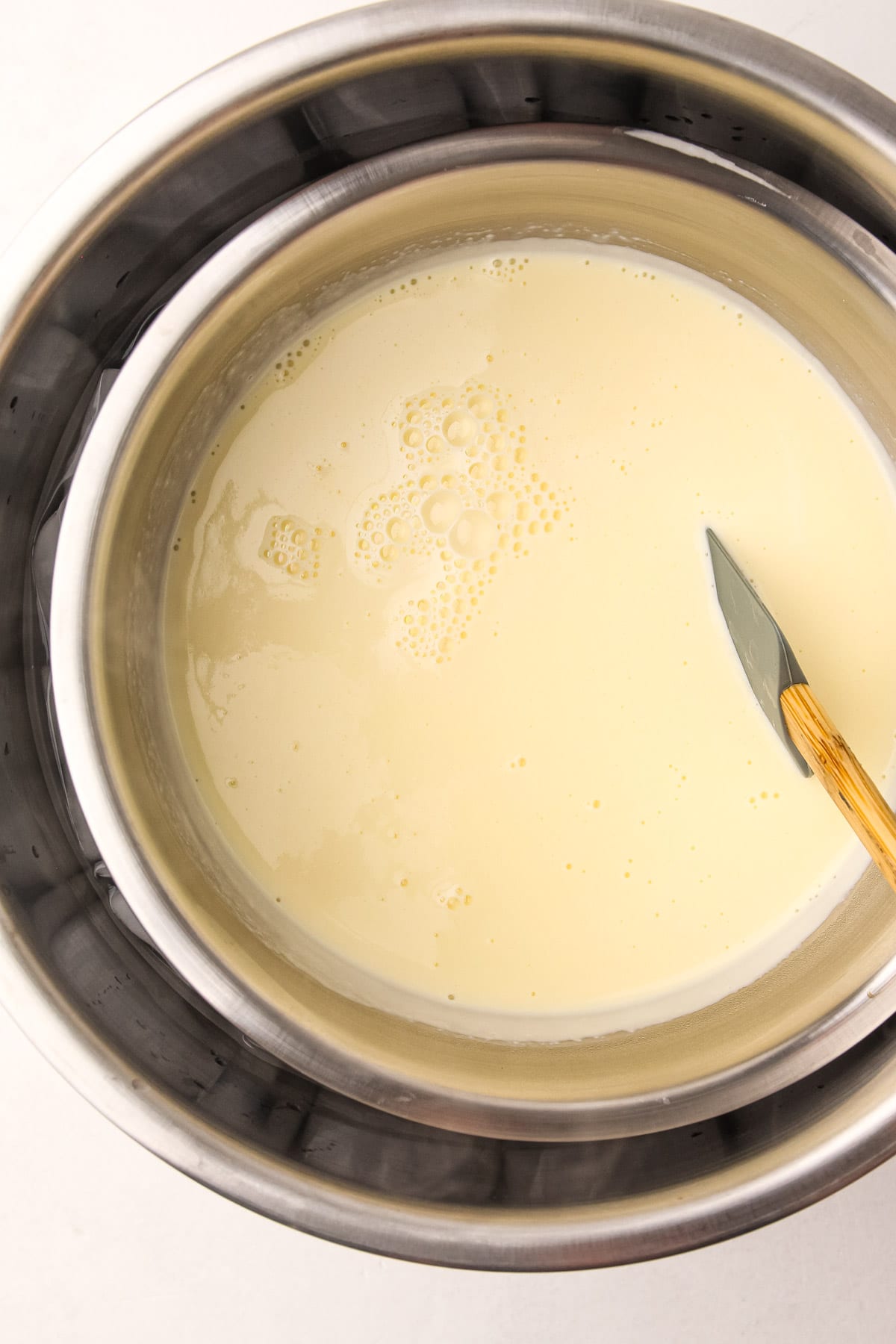
How to Make an Ice Bath
An ice bath can be used to make the cooling process go faster.
Using a metal bowl for an ice bath is important because it’s the most efficient material for heat exchange. Glass or ceramic don’t work as fast as metal. Ensure your ice bath has a bit of water in it as well as ice, as water is a more efficient conductor of heat than air. Just be sure none of the ice water spills into the custard.
Once the custard is cool, immediately transfer the ice cream mix to an airtight container to let it “ripen” or chill, preferably overnight.
It’s important to have a very cold ice cream base before it is churned, see more on that below.
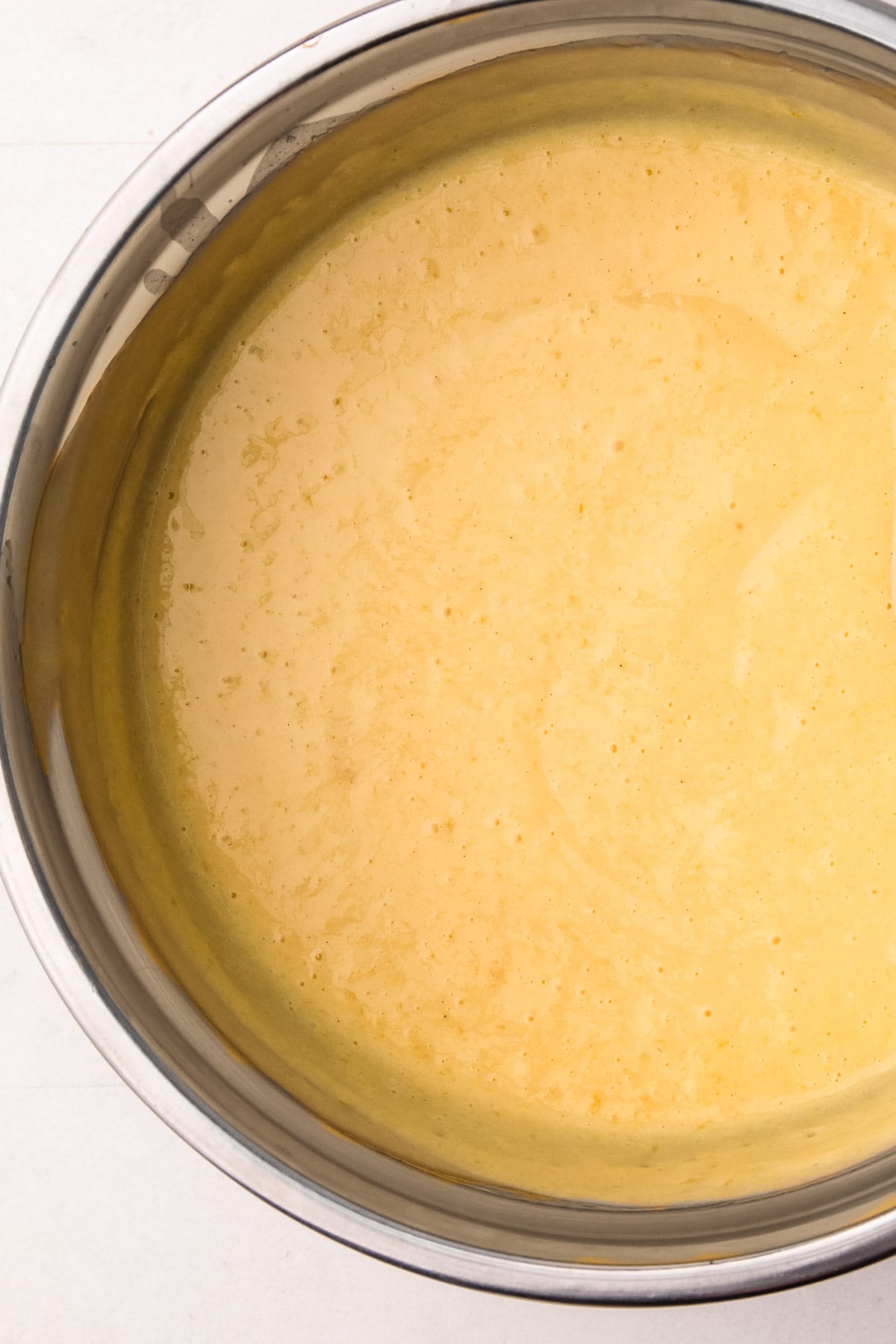
Freezing the Ice Cream
Now it’s time for the magic!
Before freezing, keep two things in mind: the ice cream base must be very cold (below 40ºF is a must, but the lower the better) and if your ice cream machine needs to be frozen, it should be in the freezer for at least 24 hours before use.
Speaking of, let’s talk about ice cream machines.
I’ve owned and operated many different types and brands of ice cream machines, ranging from the inexpensive countertop frozen canister ice cream machines to a KitchenAid attachment to my newest fancy compressor ice cream machine. While I’m definitely happy with my recent purchase, it is not necessary to make good ice cream.
If I had to recommend a model to a beginner ice cream maker, this inexpensive but trusted model is the one I’d recommend. Just make sure to freeze it thoroughly before using it!
When making ice cream at home, avoid over-churning the mixture. Excessive churning can introduce too much air into the ice cream, leading to a less dense and potentially less desirable texture.
To achieve optimal results, follow the instructions provided by the ice cream maker manufacturer and monitor the churning process closely.
Generally speaking, churn until the ice cream reaches the soft serve stage. In my machine, I notice a change in the sound it makes when the ice cream is ready.

Storing Peach Ice Cream
The last step in making homemade ice cream is to store it properly. After the ice cream has been churned and frozen, it needs to “harden” in the freezer for a period of time. This chilling period fully sets up the ice cream to the correct consistency.
The faster it hardens, the smaller the ice crystals, the smoother the ice cream.
You can harden the ice cream in one large container or multiple small containers. While dedicated ice cream containers are convenient for frequent ice cream making, any container available in your home can be used.
Here are some things to consider in terms of storage:
- It should be a container with a tight-fitting lid to help prevent air from entering and ice crystals from forming.
- It should be a container that is safe to freeze, of course! Some plastic or glass containers might not be freezer-safe.
- A shallow or small container is best because it allows the ice cream to freeze and harden more evenly and quickly.
- Make sure that the container, especially if it is plastic, does not have any residual smell from another food. Nothing will ruin an ice cream faster than storing it in a container that previously held something garlicky.
I've tried various ice cream storage solutions over the years, including glass containers, recycled take-out quart containers, and specialty-made ice cream containers. My favorite option is disposable pint containers I purchase on Amazon / at a restaurant supply store designed specifically for ice cream. They freeze the ice cream in small batches and make it easy to scoop. They also do a really great job of preventing ice crystal formation because the lids fit tightly. These containers are inexpensive to buy, but keep in mind they are not reusable.
Another option I like is using small, reusable mini containers. They are convenient because they provide individual portion sizes, allowing anyone to grab a container from the freezer without the need for scooping.
A few other factors to point out:
- Place a piece of parchment paper on the surface of the ice cream to minimize air exposure from the ice cream.
- Freeze promptly and thoroughly: Place the sealed container of ice cream in the coldest part of your freezer as soon as possible. Ensure that your freezer is set to the appropriate temperature for freezing ice cream, typically around -18°C (0°F) or lower.
- Allow enough space around the container for proper airflow and to avoid crushing or squishing the ice cream.
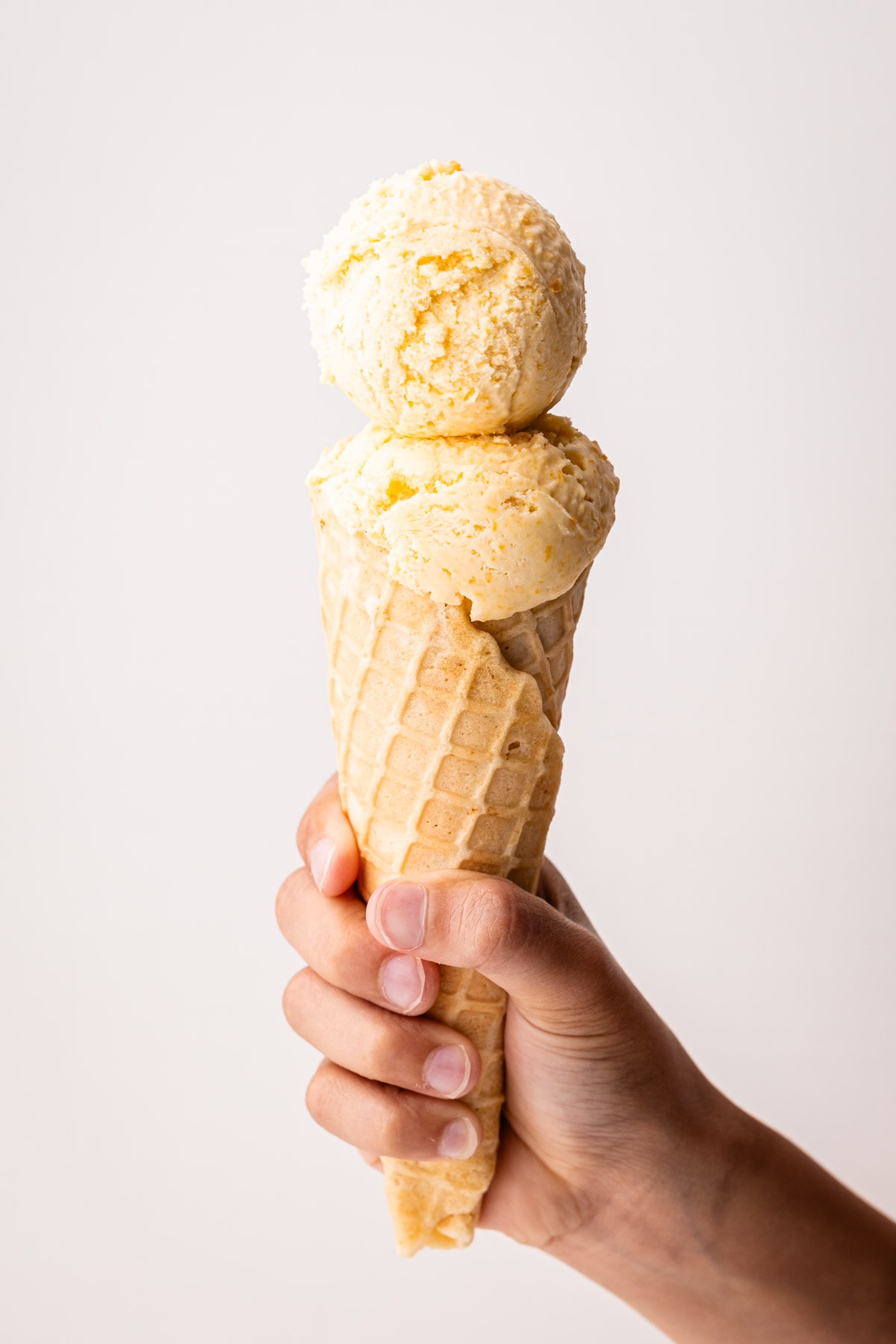
How Long Will It Keep?
Peach Ice Cream does not last as long as one might expect due to the absence of stabilizers or preservatives in its composition.
Homemade ice cream is best consumed within a week or two of making it. Different factors can affect this timeline, including how cold your freezer is, what type of ice cream it is, what container it is kept in, and if it has thawed at any point in the freezing process.
Over time, ice cream will develop freezer burn and change taste and texture, so for the best possible ice cream, consume it sooner rather than later.
More Ice Cream Recipes
I am so honored when you make a recipe from my site! If you make this Peach Ice Cream recipe, please leave a comment and a star rating with your experience! If you have any questions about this recipe, feel free to comment here, too!
Full Recipe
Peach Ice Cream
This is the best Peach Ice Cream recipe, made using simple ingredients like eggs, cream, milk, and fresh peaches for an ultra-creamy and fruit-forward taste and consistency. This is a classic peach ice cream recipe made with a custard base that requires an ice cream churner.
- Prep Time: 00:20
- Churning Time: 00:30
- Total Time: 00:50 + chilling time
- Yield: 3 Pints
- Category: Ice Cream
- Method: Churn
Ingredients
- 14 ounces (about 2 cups) peeled, pitted and diced ripe peaches
- 1 cup (200 grams) granulated sugar, divided
- 1 tablespoon lemon juice
- ¼ teaspoon coarse kosher salt
- 2 tablespoons (15 grams) dry milk powder
- Pinch cinnamon
- 2 large eggs
- 1-½ cups (340 grams) heavy cream
- ½ cup (115 grams) whole milk
- ¼ teaspoon almond extract
Instructions
- Stir together peaches, ½ cup of sugar, lemon juice and salt in a medium pot. Let macerate until the sugar has dissolved, about 5 minutes. Cook over medium heat until bubbling. Reduce the heat to medium-low and simmer for 5 minutes.
- Shut off the heat. Using an immersion blender, blend until mostly pureed, with small bits of peach pieces remaining. Set the peach puree aside.
- Set up an ice bath with two nesting metal bowls.
- In a bowl, whisk together the remaining ½ cup of sugar, milk powder, and pinch of cinnamon. Add in the eggs and whisk vigorously for one minute, until the mixture is lightened.
- Whisk in the cream and milk.
- Transfer the mixture to a clean heavy-bottomed medium pot.
- Cook over medium heat, stirring constantly, especially along the edges and the bottom of the pot. Cook until the mixture reaches 175°F on an instant-read thermometer, about 8 minutes. The mixture will be slightly thickened. To check the custard is set without an instant-read thermometer, take a wooden spoon and coat it with custard. Draw a horizontal line on the back of the spoon with your finger. If the line “holds” then your custard is set. If the line collapses immediately, the custard needs another minute or so. Be careful not to bring the mixture to a boil; this will curdle the custard.
- Immediately shut off and remove the pot from the heat. Continue to stir the custard for 1 minute. This helps bring it all the way up to 180ºF.
- Strain the custard into the prepared ice bath through a fine-mesh strainer. Stir in the peach puree and almond extract.
- Cool the custard in the ice bath to room temperature, stirring occasionally.
- Chill the custard thoroughly in the refrigerator, until at least 40ºF, but preferably overnight.
- Churn the custard, according to the recommended manufacturer’s instructions of the ice cream maker, until the ice cream has reached a soft-serve consistency.
- Transfer the ice cream to one or more airtight containers. Place a piece of parchment on the surface to prevent any freezer burn. Freeze until firm, at least a few hours.
Notes
Have a question or looking for tips? The text written above the recipe is always a great first place to start! This Peach Ice Cream was developed with love, and I always include loads of explanations, tips, step-by-step photos and technical advice shared before the recipe.
The total weight of peaches used for this recipe after the peaches are peeled and pitted is 14 ounces.
You can use high-quality frozen peaches here if you want. Let them defrost in the sugar and lemon juice in the pot in step 1 of the recipe.
Milk powder can be found in most grocery stores in the baking aisle. It is highly recommended for this recipe, but if you absolutely cannot find it, you can skip it. It will result in less creamy ice cream that may be harder to scoop.
Homemade ice cream is best consumed within a week or two of making it. Different factors can affect this timeline, including how cold your freezer is, what type of ice cream it is, what container it is kept in, and if it has thawed at any point in the freezing process. To help prevent freezer burn, place a piece of parchment paper on the surface of the ice cream in the storage container to minimize air exposure from the ice cream. Freeze promptly and thoroughly. Store the ice cream container in the coldest part of your freezer immediately.
Pin it for later:
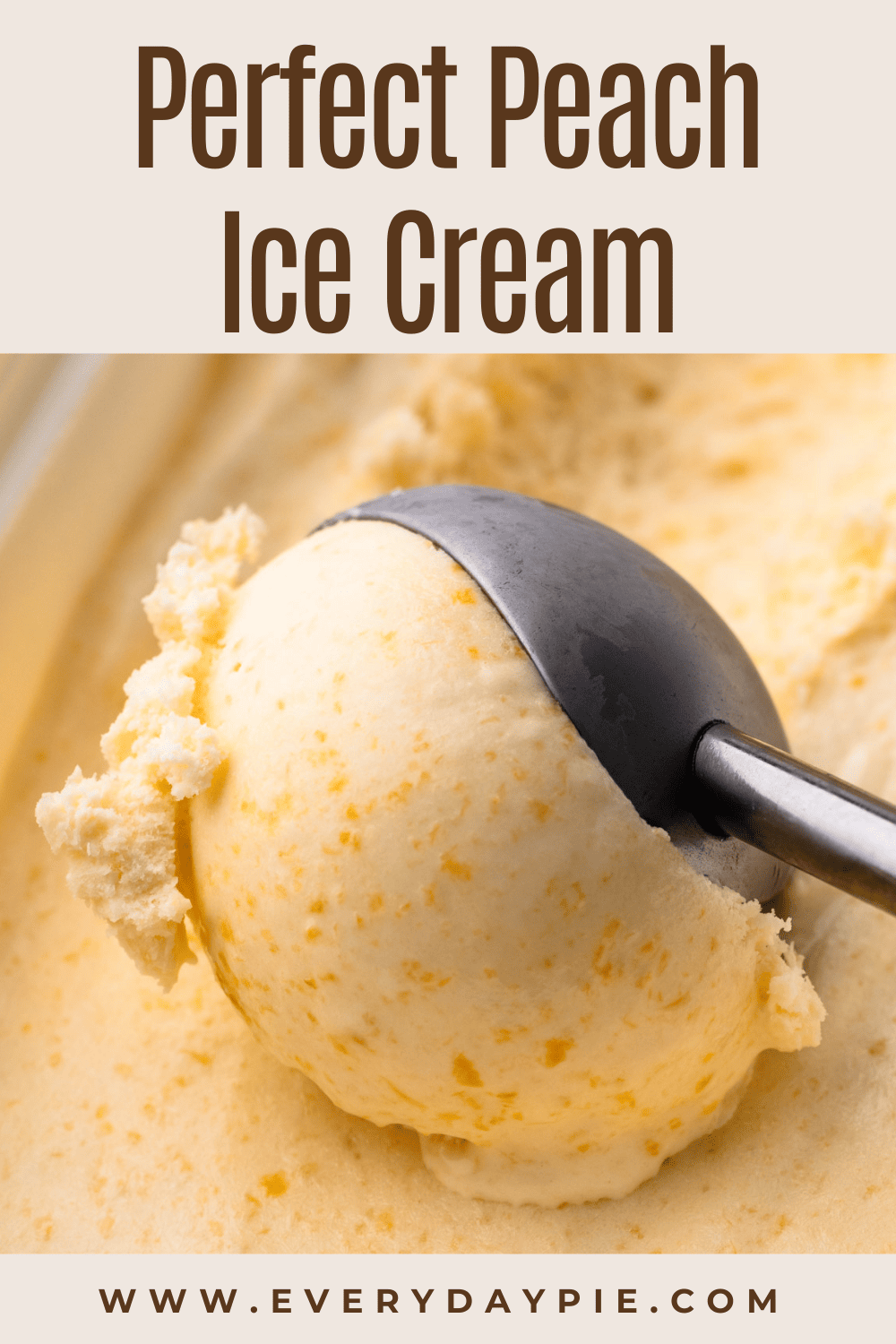
Some of the links on this page may be affiliate links. Everyday Pie is a participant in the Amazon Associates Program. As an Amazon Associate I earn from qualifying purchases, at no extra cost to you.





Callan
SO peachy and delicious! I loved the touch of almond and cinnamon. I actually made 2 batches, one with the milk powder and one without just to see how much of a difference there was in texture. The milk powder makes a HUGE amount of difference in creaminess. Super yummy, thanks for this, Kelli!
Kelli Avila
Callan, doing the people's work! So glad you liked it. Thanks for taking the time to share your experience and experiment! -Kelli
HT
Loved the texture and mouthfeel of this ice cream. A great way to use summer peaches and whole eggs. I will say that the almond extract was a little overpowering — next time I make this I might tone it down to just a few drops rather than 1/4 teaspoon. Otherwise delicious!
Brandy J
Great, easy to follow recipe and the ice cream was so rich and creamy. Yum!
Laurie
I had been looking for a peach ice cream recipe for quite a long time that wasn't overly complicated and seemed to have lots of flavor when I finally found this one. I have to say that I'll never need to look for another! This recipe is so amazing and is full of peachy goodness!Thank you so much for doing all of the hard work in perfecting it and sharing it with us!!
KBC
Best peach ice cream recipe. I followed the recipe exactly. The texture is perfect and the peach flavour shines. This way of making the ice cream base (without tempering the eggs) is a game changer!
Sheila
The peach ice cream was delicious, the texture/chew perfect, and steps easy. The only thing I would do differently is puree the peach goo more. That's on me as I thought I wanted bigger chunks
Alyssa
This is such a delightful ice cream. Great texture and only 2 eggs! I will definitely be trying out more of these ice cream recipes.